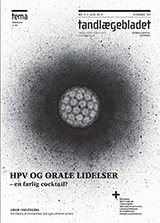Humant papillomavirus i orale lidelser med malignt potentiale
Der findes stærke indikationer for, at der oftere forekommer HPVinfektion, herunder HPV-16 i OLMP end i klinisk sund mundslimhinde.
Introduktion – Humant papillomavirus (HPV) er i dag anerkendt som den vigtigste enkelte ætiologiske faktor til cervixcancer, og det er nu blevet klart, at der også findes en sammenhæng mellem HPV og undergrupper af hoved-halscancer. Sammenhængen mellem HPV og en andel af orale cancere er også undersøgt, særligt grundet den stigende incidens af oral cancer på trods af et fald og en stagnering i forbruget af risikofaktorer som tobak og alkohol. Tandlægen ser ofte orale lidelser med malignt potentiale (OLMP) i mundslimhinden, og mellem 20-50 % af orale cancere menes at forudgås af OLMP.
Formål – At belyse prævalensen af HPV i OLMP og diskutere betydningen af HPV for malign udvikling af disse forandringer. Materiale og metode – På baggrund af litteratursøgning beskrives, hvordan HPV associeres til OLMP, herunder specifikt leukoplaki, erytroplaki og oral lichen planus samt forekomsten af HPV i sund mundslimhinde. På denne baggrund diskuteres mulige konsekvenser af en eventuel sammenhæng mellem HPV og malign udvikling af OLMP, herunder fremtidig udvikling af diagnostik og behandling.
Resultater og konklusion – Der findes stærke indikationer for, at der oftere forekommer HPVinfektion, herunder HPV-16 i OLMP end i klinisk sund mundslimhinde. Der mangler dog stadig epidemiologisk evidens i litteraturen, som kan underbygge en association mellem malign udvikling og HPV i OLMP. Der er behov for prospektive studier for at belyse dette.
Klinisk perspektiv:
Orale forandringer med malignt potentiale ses relativt hyppigt (2-4 %) af tandlæger afhængigt af diagnose. Tillige ses stig-ning i incidens af oral cancer i Danmark på trods af et fald i kendte risikofaktorer som ryg-ning og alkoholforbrug. HPV associeres til hoved-hals-kræft og menes at være årsag til cancer hos ofte yngre patien-ter uden kendt risikoadfærd. Således bør tandlægen også have særlig opmærksomhed på mundslimhinden hos denne patientgruppe. Tandlægen er ekspert i mundslimhinden og understøtter diagnostik, op-følgning og behandling af orale lidelser med malignt poten- tiale, hvor HPV-infektion fore-kommer hyppigere end i klinisk sund mundslimhinde. Den prospektive betydning ved tilstedeværelsen af HPV er endnu uafklaret.
The role of human papillomavirus in oral potentially malignant lesions
Introduction – Human papillomavirus (HPV) has been recog-nized as the principal etiological factor in the development of cervical cancer, and furthermore linked to a subset of head and neck cancer. This may explain the recent increase in cases of oral cancer, despite the decline and stagnation of the two known car-cinogenic risk factors tobacco and alcohol. Oral potentially ma-lignant disorders (OPMD) are frequently observed by the dentist, and are believed to precede 20-50% of oral cancers.
The aim – To elucidate the prevalence of HPV in OPMD and the influence of HPV on the malignant progression of these lesions.
Material and methods – Based on literature search the associa-tion of HPV and OPMD in particular: leukoplakia, erythroplakia, and oral lichen planus is described. Also the prevalence of HPV in OPMD and apparently healthy oral mucosa is investigated. On this basis, we discuss the possible link between HPV and ma-lignant development of OPMD, including future development in diagnosis and treatment.
Results and conclusion – We conclude that indications of HPV infection, in particular HPV-16, more often occurs in OPMD than in apparently healthy oral mucosa. Still, in the literature there is no epidemiological evidence to substantiate an association between in the malignant development and HPV in OPMD. Prospective studies are needed to elucidate this.


